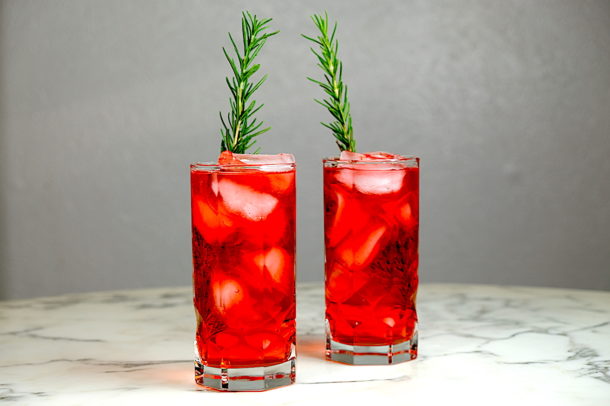My Campari Gin & Tonic with Bruised Rosemary is a great spin on the classic gin and tonic recipe. We’ve been adding bitters to cocktails since the 1800s. These highly concentrated extracts are potent, boozy little flavor bombs. Adding a few dashes of bitters to cocktails adds complexity, depth, and character. Campari and tonic water both have slightly bitter qualities that highlight and enhance the herbaceous gin.
The Campari Gin & Tonic with Bruised Rosemary, these bitters bring all of the gins’ best qualities to the forefront. The Campari adds a nice amount of herbal, citrusy bitters to the gin and tonic, although subtle, also has a nice bitter quality to it. Bruising rosemary brings an intense aroma to this awesome variation on the classic gin and tonic. Combined with the flavors and aroma of the Campari and the gin creates a gorgeous perfume that will awaken your senses before your first sip.
Never Shake a Gin and Tonic
Gin has an interesting similarity with red wine and aeration. I’ll use this as an example of why never to shake a gin cocktail. We are all familiar with the practice of letting red wine ‘breathe’. Decanting red wine, swirling the wine in the glass, and exposing it to oxygen for a short time will soften the flavors. This allows some of the more volatile aromas to escape and release the more pleasant fruit and oak aromas in the wine. However, if allowed to breathe for too long the finer subtle qualities of the wine will not only disappear but eventually, the wine turns to vinegar.
Gin is very similar to red wine in this matter. Shaking gin accelerates the breathing process exponentially.
Gin has a complex mixture of aromas divided into three parts; top notes, middle notes, and base notes. With gin, the most desirable qualities are in the top note. All of the botanicals: juniper, pine, fruit, spice, and floral are top notes. Unfortunately, when gin has been agitated by shaking, the top notes are the first to go. Leaving only the less desirable middle and base notes. Bruising the gin won’t turn it to vinegar, but it will leave the gin dull and lifeless. All of the amazing botanicals that are so desirable lost to the inside of a cocktail shaker.
What is Tonic Water?
A classic mixer for with gin, tonic water gets its bitter flavor from Quinine, a medicine used to prevent Malaria. In the 1800s in order to make the quinine more palatable the British military stationed in India, mixed the extremely bitter medicine with seltzer and lemon, thus the birth of ‘Tonic Water’. Today tonic water doesn’t actually have enough quinine in it to be medicinal, it’s just there for the slightly bitter flavor it gives this amazing gin mixer.
Campari
I love the addition of Campari to this gin and tonic variation. Campari’s brilliant red color and slightly bitter flavor come from its infusion of a secret combination of fruits and herbs in alcohol. It is the base for several classic cocktails including the Negroni, with new Campari cocktails (like this one) being invented every day.
Bruising Herbs
Rosemary is a tough, fibrous herb, its needle-like leaves have a texture similar to pine needles. Uncooked, it can have a bitter astringent flavor. I choose not to muddle the rosemary into this gin and tonic, rather I want to simply bruise the leaves to release their aroma.
To bruise the rosemary: simply lay it on a sturdy flat surface and using the dull edge of a knife, gently crush and scrape in the direction of the leaves. You don’t want to damage the leaves, just gently bruise them.
This is my recipe for a Campari Gin and Tonic with Bruised Rosemary

Campari Gin and Tonic with Bruised Rosemary
Ingredients
- 2 Ounces Gin
- 2 Ounces Campari
- 3 Ounces Tonic Water
- 1 Sprig Fresh Rosemary
Instructions
- Combine gin and Campari over ice in a cocktail shaker, stir until ice cold
- Pour the mixture into a highball glass over ice and top off with tonic water
- Use the back of a knife or muddler to gently bruise the leave of the rosemary and release its aroma. Garnish with rosemary.
